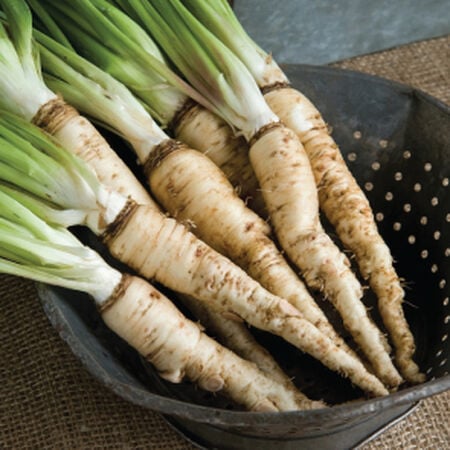Mammoth, Salsify Seeds
Key Attributes
Key Attributes
Product Details
Weight
0.006Depth
0.1Height
4.5Width
3.25Plant Height
2-3'Botanical Name
Tragopogon porrifoliusSeed Type
SeedSeeds Per Gram
94Seeds Per Pound
42,750Row Spacing
18-24"Packet
200 SeedsSow Depth
1/2"Seeds Per Ounce
2,672Breed
Open-pollinatedSun
Full SunLife Cycle
AnnualSow Method
Direct SowPlant Spacing
1"Categories
SalsifyGermination
4,5,6,7,8,9Days To Maturity (# Days)
120Heirloom
HeirloomSeeds Per Acre
11 lbsComponents
Growing Instructions
![]() Learning Download: How to Grow Salsify
Learning Download: How to Grow Salsify
Salsify, also known as the oyster plant because of its light oyster flavoring, is a root vegetable not commonly found in grocery stores. The vegetable is similar to a carrot, but with white flesh. The young roots can be eaten raw if finely shredded onto a salad, but the roots are usually cooked in stews. Salsify has a longer growing season but is relatively simple to grow and can be a unique addition to any garden. Although it looks similar to a carrot, salsify is actually related to the dandelion and chicory.
Before Planting: Salsify can be grown over the winter in warmer climates or planted in the spring in cooler climates.
Planting: Salsify prefers a deep and well draining soil. Sow late spring,1″ apart, ½” deep, in rows 18–24″ apart. Do not allow soil to dry out prior to emergence. Thin plants to 2–3″ apart.
Watering: Since it is a root plant, salsify also requires frequent, deep water.
Fertilizer: Salsify requires frequent weeding, as the plants are such slow growers that fast-growing weeds can overtake them. Mulching around the plants can help deter weeds
Days to Maturity: Salsify is ready to harvest when the roots
are 12 inches in length. This can be up to 120 days after planting.
Harvesting: Dig roots in late fall just before the ground freezes. Flavor is best after several frosts. In mild areas, a portion of the crop may be left in the garden for spring harvest, as salsify is cold hardy. Apply a mulch or row cover in cold regions for winter survival insurance. Overwinter in soil or store in root cellar.
Tips: Carrot rust flies and wireworms can be pests that cause problems to your salsify plants. To deter carrot rust flies, spray insecticides or use outdoor sticky traps. For wireworms, leaving a cut piece of potato nearby will distract the pests from the salsify plants.
AVG. Seeding Rate: 1 oz./130′, 7.7 oz./1,000′, 10.5 lb./acre at 20 seeds/ft. in rows 24″ apart.
Shipping Schedule
Our Seed Promise
 "Agriculture and seeds" provide the basis upon which our lives depend. We must protect this foundation as a safe and genetically stable source for future generations. For the benefit of all farmers, gardeners and consumers who want an alternative, we pledge that we do not knowingly buy or sell genetically engineered seeds or plants.
"Agriculture and seeds" provide the basis upon which our lives depend. We must protect this foundation as a safe and genetically stable source for future generations. For the benefit of all farmers, gardeners and consumers who want an alternative, we pledge that we do not knowingly buy or sell genetically engineered seeds or plants.
The mechanical transfer of genetic material outside of natural reproductive methods and between genera, families or kingdoms, poses great biological risks as well as economic, political, and cultural threats. We feel that genetically engineered varieties have been insufficiently tested prior to public release. More research and testing is necessary to further assess the potential risks of genetically engineered seeds. Further, we wish to support agricultural progress that leads to healthier soils, to genetically diverse agricultural ecosystems, and ultimately to healthy people and communities.
To learn more about the "Safe Seed Pledge" please visit www.councilforresponsiblegenetics.org.

